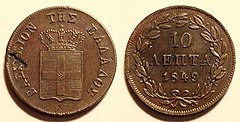Greek lepton

The lepton, plural lepta (
Hellenistic times a lepton was always a small value coin, usually the smallest available denomination of another currency.[1]
The coin in the
Hasmonean Kingdom the lepton was first minted under Alexander Jannaeus prior to 76 BCE.[3]
In
modern Greece, lepton (modern form: lepto, λεπτό) is the name of the 1⁄100 denomination of all the official currencies of the Greek state: the phoenix (1827–1832), the drachma (1832–2001) and the euro (2002–current) – the name is the Greek form of "cent". Its unofficial currency sign is Λ (lambda).[1]
Since the late 1870s, and until the introduction of the euro in 2001, no Greek coin had been minted with a denomination lower than 5 lepta.
-
20-lepton coin, Phoenician subdivision, 1831.
-
5-lepton coin, drachma subdivision, 1833.
-
10-lepton coin, drachma subdivision, 1849.
-
One-lepton coin of 1879, the last one-lepton coin of the drachma issued.
-
2-lepton coin 1869. The last two-lepton coins were minted in 1878.
-
An ancient mite of a type still circulating in Jesus' time, typical of what might have appeared in the Bible's lesson of the widow's mite.
References
- ^ a b Fleur de Coin - Greek 50 Lepta Coins
- ^ Luke 12:59
- ISBN 0-7948-1889-7
External links






